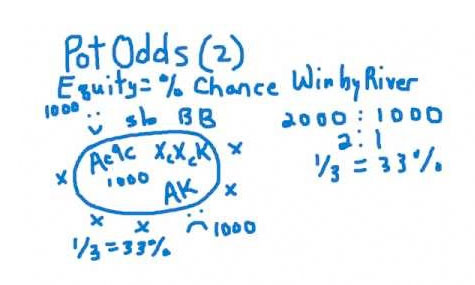Poker Odds Strategy | How to calculate pot odds and equity: pot odds
How to calculate pot odds and equity: pot odds

Being able to calculate the odds can be quite hard.
Is this a fact or not? Everything you decide to do at poker tables can be made by feeling, with no crucial concern for the real numbers you face.
This is not true. There are certain choices at the table which need no concern of odds, like calling an all-in bet when you are holding the nuts on the river. The plays made quite clear on a read of your challenger, all the decisions are made by estimating the odds.
The players by feel, who do not make any sort of calculations at the table, also play the odds. They do not have the idea of the numbers related to what feels like a good decision to them.
In order to make use of numbers to determine the worth of your choices, you must evaluate the pot odds and the equity and later make a comparison. Should the odds happen to be greater than the equity, it means that you are making cash; but if the equity happens to be greater than the odds, it means that you are losing cash.
You can begin with your hand equity or your pot odds. Every number is independent of each other, but the numbers are very useless until you have them both to calculate.
We shall look at what is referred to as pot odds in this particular article and look at the hand equity in part two.
The pot odds
Add up the pot: once the pot is grown big, it is very hard to add it up, particularly when there are chips of a lot of denominations collected together. The best thing to do is to keep a count of the whole pot as the hand carries on.
$2/$5 game: UTG raises to$15; folded to the cut-off, who calls. The button calls just as the small blind and the big one folds.
What is the pot? Trying to count the pot at this state is a little bit hard, but if you have the running total in your head, it will be easier.
When you are careful of the pre-flop action, it really helps to pay no attention to the blinds after they have acted; if not you have to minus from your total what they had from what they called, adding up the difference to your total.
If you begin at UTG it is very easy: UTG raises to $15,cut-off calls ($30),the button calls $45,the small blinds calls $60 and the large blind folds $65.
Form a ratio: just like the state above, the pre-flop raiser bets out $50. The question is: what are the pot odds in the cut-off.
You have to add up the bet to the sum of the pot, making the total pot $115. The player needs to call $50 for a pot of $115. This forms your first ratio which is $115-$50. To be able to work things with ease, we need to make the right side of the ratio 1. Since I know all of you do not remember your grade nine math:
115-50: if you want to change the right to a 1, you must divide it by itself (50/50=1). If you calculate one side of the ratio you must also calculate the other side so 115/50=2.3. This makes your new ratio 2.3-1.
The cut-off pot odds are 2.3-1.
Here, is a trap to doing the final calculation in your head. You do not have to be accurate at the table, all you need is to get yourself close. To separate two of the numbers, take out the lump that appears to be large and the divisor goes into with no fraction.
We understand that 100/50=2 and 150/50=3. Since 150 is bigger than the number, the largest lump that we can take out is 100. We now have the idea that our first number is a 2. That leaves us with 15(115-100).
Nearly how many times do 15 go into 50? 15 multiplied by 3 equals to 45. This is what we can get because 45 is closer to 50 than 60. This creates our second number, the remainder of 3. Join the two together and what we have is 2:3. In this example the shortcut method brings the right example.
For example, the cut-off calls. The calls to the button will be what? Try calculating that in your head. If you have problems calculating that here is a step to guide you:
Pot=$115+$50
Pot=$165
Odds=$165/$50
50*3=150 the first number happens to be 3
165-150=15
50/15=close to 3
Odds=3.3:1
With a bit of luck you caught on to a very important shortcut. After calculating the odds for the cut-off and he calls, the odds that are on the button will be better than one: 2.3+1=3.3. If one player only calls, then there is no point to calculate again, just add up one, you can only recalculate when another player raises.
You will actually learn how to calculate the hand equity and also how to compare the two numbers to get your result in part two.
- How to calculate pot odds and equity: equity - Online Poker Rewards Community





1 Comment